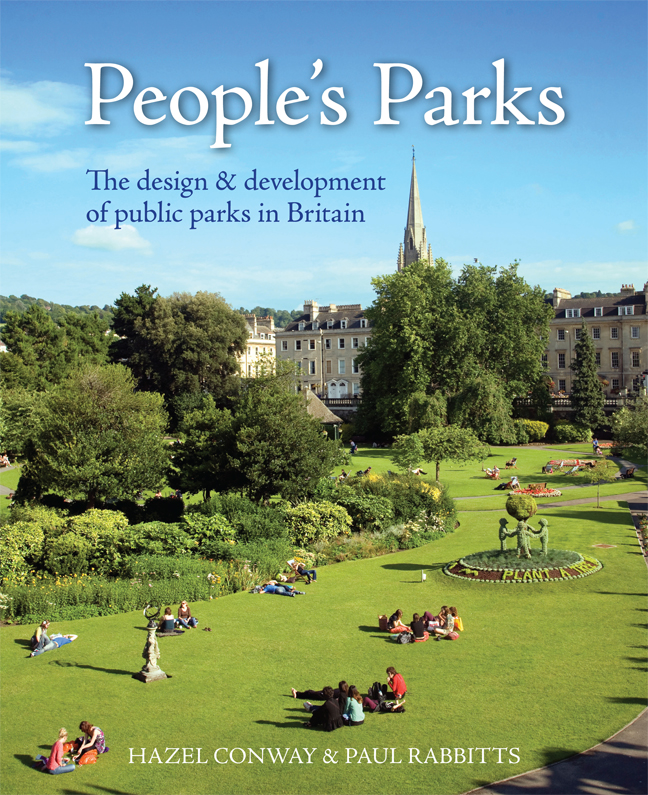Book contents
- Frontmatter
- Dedication
- Contents
- Miscellaneous Frontmatter
- Preface
- Acknowledgements
- Foreword
- A Word from Parks Professionals, Politicians and Parks Organisations
- Introduction: Dr Hazel Conway (1991)
- 1 Public Parks and Municipal Parks
- 2 The Need for Parks
- 3 Pioneering Parks Development
- 4 The Park Movement
- 5 Design and Designers
- 6 Lodges, Bandstands and the Cultivation of Virtue
- 7 Local Pride and Patriotism
- 8 Planting and Park Maintenance
- 9 Permitted Pastimes
- 10 Recreation Grounds, Parks and the Urban Environment
- 11 Public Parks, 1885–1914
- 12 Later Municipal Park Designers
- 13 Garden Cities and the New Towns Movement
- 14 Sport, Physical Activity and Recreation in Public Parks in the Inter-war Years
- 15 Parks Management – a Changing Perspective
- 16 Decline, Revival and Renewal – the Role of Parks into 21st-century Britain
- Appendix 1 Summary of main legislation promoting early park development
- Appendix 2 Chronology of main municipal and public park developments between 1800 and 1885
- Notes
- Bibliography
- Subscription List
- Index
Introduction: Dr Hazel Conway (1991)
Published online by Cambridge University Press: 22 February 2024
- Frontmatter
- Dedication
- Contents
- Miscellaneous Frontmatter
- Preface
- Acknowledgements
- Foreword
- A Word from Parks Professionals, Politicians and Parks Organisations
- Introduction: Dr Hazel Conway (1991)
- 1 Public Parks and Municipal Parks
- 2 The Need for Parks
- 3 Pioneering Parks Development
- 4 The Park Movement
- 5 Design and Designers
- 6 Lodges, Bandstands and the Cultivation of Virtue
- 7 Local Pride and Patriotism
- 8 Planting and Park Maintenance
- 9 Permitted Pastimes
- 10 Recreation Grounds, Parks and the Urban Environment
- 11 Public Parks, 1885–1914
- 12 Later Municipal Park Designers
- 13 Garden Cities and the New Towns Movement
- 14 Sport, Physical Activity and Recreation in Public Parks in the Inter-war Years
- 15 Parks Management – a Changing Perspective
- 16 Decline, Revival and Renewal – the Role of Parks into 21st-century Britain
- Appendix 1 Summary of main legislation promoting early park development
- Appendix 2 Chronology of main municipal and public park developments between 1800 and 1885
- Notes
- Bibliography
- Subscription List
- Index
Summary
‘To sit in the shade on a fine day, and look upon verdure, is the most perfect refreshment’, said Fanny, the heroine of Mansfield Park, and her feelings strike a chord of recognition, particularly among urban dwellers. Nowadays we visit the country to find verdure, or we walk in our local park, but at the time that Jane Austen was writing, and indeed for the greater part of the 19th century, such ‘perfect refreshment’ was unavailable to the majority of people living in Britain's industrial centres. Today (1991) almost every town of any size has a number of open spaces, parks, commons and recreation grounds, which vary in size from several hundred acres to less than one. Their designs range from the simple to the very sophisticated, and they contribute green space to built-up areas and form an important part of the urban environment, whether they be large or small, simple or complex.
My interest in parks generally and municipal parks in particular grew out of my researches in landscape design, my studies of Victorian architecture, and my good fortune in having lived much of my life near public parks. The local park plays an important role in many people's lives, even today when there are many other choices of activity and many other places to go to. Municipal parks were brought into being via many complex factors, which in turn influenced their design and use. This is a very rich subject, involving as it does social, economic and political history, recreation, landscape design, architecture, sculpture and the urban environment. There have been many detailed studies of aspects of the Victorian city: working-class housing, suburbanisation, the development of transport, railway stations, public houses, town halls and the activities of the building industry have all had their historians. Municipal parks have by comparison received far less attention, although individual parks have been studied, and there is a wealth of information on the royal parks. It is my hope that this book will make a useful contribution to this area. Perhaps one reason for the lack of attention paid by landscape historians to municipal parks lies in the term ‘municipal’ itself. By the 1870s ‘municipal’ had become synonymous with lively pride in local powers and their ability to effect positive change.
- Type
- Chapter
- Information
- People's ParksThe design & development of public parks in Britain, pp. xvii - xxiiPublisher: Boydell & BrewerPrint publication year: 2023



